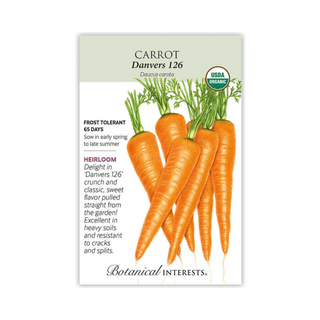
Description
Growers in Danvers, Massachusetts during the late-19th century were searching for a carrot with improved color, yield, and uniformity. After many variations, the 'Danvers 126' carrot was born! It grows particularly well interplanted with onions and in heavy soils due to its high fiber content. Heat-tolerant with high yields, it also has a noticeably sweeter flavor and stores exceptionally well if cleaned after harvest. Resistant to cracks and splits.
Variety Info
- Family: Apiaceae
- Native: Africa, Eurasia
- Hardiness: Frost-tolerant biennial grown as an annual
- Exposure: Full sun
- Plant Dimensions: Roots are 6"–7" long at their peak
- Variety Info: Orange roots, wide at the top, tapering to a point. 'Danvers 126' is a Danvers type carrot
- Attributes: Crack Resistant, Frost Tolerant
Sowing Info
-
When to Sow Outside: RECOMMENDED. 2 to 4 weeks before your average last frost date, and when soil temperature is at least 45°F, ideally 60°–85°F. Successive Sowings: Every 3 weeks until 10 to 12 weeks before your average first fall frost date. In very warm climates, carrots are grown primarily in fall, winter, and spring
- When to Start Inside: Not recommended, root disturbance stunts growth
- Days to Emerge: 10–25 days
- Seed Depth: ¼"
- Seed Spacing: 1"
- Thinning: When 1" tall, thin to 1 every 3"
Growing Info
- Harvesting: For best flavor and texture, harvest carrots any time before, and until they reach their optimal size. Peak harvest period lasts about 3 weeks, longer in the fall. Late summer-sown carrots are sweetened after having been kissed by light frost; however, harvest before soil freezes, which may destroy the crop. In USDA zone 5 or warmer, carrots can be left in the ground for storage provided they are heavily mulched; harvest as needed on days the ground is not frozen.
Description
Growers in Danvers, Massachusetts during the late-19th century were searching for a carrot with improved color, yield, and uniformity. After many variations, the 'Danvers 126' carrot was born! It grows particularly well interplanted with onions and in heavy soils due to its high fiber content. Heat-tolerant with high yields, it also has a noticeably sweeter flavor and stores exceptionally well if cleaned after harvest. Resistant to cracks and splits.
Variety Info
- Family: Apiaceae
- Native: Africa, Eurasia
- Hardiness: Frost-tolerant biennial grown as an annual
- Exposure: Full sun
- Plant Dimensions: Roots are 6"–7" long at their peak
- Variety Info: Orange roots, wide at the top, tapering to a point. 'Danvers 126' is a Danvers type carrot
- Attributes: Crack Resistant, Frost Tolerant
Sowing Info
-
When to Sow Outside: RECOMMENDED. 2 to 4 weeks before your average last frost date, and when soil temperature is at least 45°F, ideally 60°–85°F. Successive Sowings: Every 3 weeks until 10 to 12 weeks before your average first fall frost date. In very warm climates, carrots are grown primarily in fall, winter, and spring
- When to Start Inside: Not recommended, root disturbance stunts growth
- Days to Emerge: 10–25 days
- Seed Depth: ¼"
- Seed Spacing: 1"
- Thinning: When 1" tall, thin to 1 every 3"
Growing Info
- Harvesting: For best flavor and texture, harvest carrots any time before, and until they reach their optimal size. Peak harvest period lasts about 3 weeks, longer in the fall. Late summer-sown carrots are sweetened after having been kissed by light frost; however, harvest before soil freezes, which may destroy the crop. In USDA zone 5 or warmer, carrots can be left in the ground for storage provided they are heavily mulched; harvest as needed on days the ground is not frozen.

